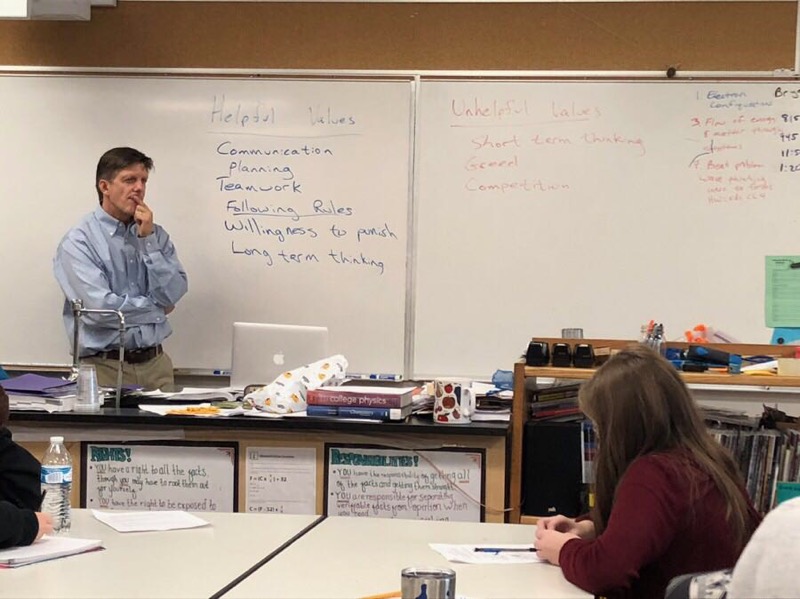
The Alaska Department of Education and Early Development is in the process of revamping its science standards. It hopes to have a draft released by March. But for the past 13 years, teachers have been working with a curriculum that gives little guidance on how to explain the science behind one of Alaska’s most pressing problems: climate change.
This week, we’re going inside two Alaska classrooms to learn how teachers and students are navigating these difficult conversations.
Bryan Smith is the kind of teacher who goes by his first name in his classroom at Polaris K-12 School in Anchorage. You could call his teaching style eclectic.
Today, his class of high school students are learning about resource extraction by competing to grab Goldfish crackers off of a row of tables. Snatch too many goldfish and you deplete the fishery.
“As soon as I saw people taking more than three fish, I knew it was over for me,” Kadi LeBlanc, a ninth-grader, says with a laugh.
She says not everyone is playing fair. But she understands the point.
“If people are greedy and take more than an ecosystem can handle, by the end no one be able to use that resource,” LeBlanc said. “It’ll be gone.”
Later, the class brainstorms helpful values for solving the problem. They list things like communication, planning and following rules or regulations.
It sounds like students are having a good time. But Bryan acknowledges these are tough things to talk about, especially in a resource-dependent state.
“I’ve got this Upton Sinclair quote above my door: ‘It’s difficult to get a man to understand something when his salary depends on his not understanding it.'”
That quote alludes to the tightrope discussions Bryan has to have with his students. Some of their parents are employed by the oil and gas industry. Bryan says it can be a sensitive topic; the business that’s feeding some families is also contributing to an increase in carbon emissions.
So there are the social complexities of teaching about climate change in an oil state, and then there are the emotional ones.
“One of the reasons why I suspect other teachers might not want to jump into this, besides it being a political hot topic … it’s heavy and it’s a real downer,” Bryan says.
Bryan says the future can appear increasingly uncertain, dangerous and even scary for kids.
He describes it as taking an unblinking look into the void. Alaska is warming twice as fast as the global average temperature.
So the students in his classroom are given a choice.
And this is where Bryan takes another page from one of the great contemporary works: “The Matrix.”
He uses an iconic scene from the dystopian sci-fi thriller in class. In the movie, Morpheus tells the protagonist Neo that there’s no turning back.
“You take the blue pill, the story ends, you wake up in your bed and believe whatever you want to believe,” Morpheus explains. “You take the red pill, you stay in wonderland, and I show you how deep the rabbit hole goes.”
Bryan says he has had one student tell a counselor, “I don’t want want to take this class.”
Of course, Bryan’s not presenting his class of middle and high school students with real pharmaceuticals. It’s a metaphor. Take the blue pill and drop the elective science class. Or, take the red pill and learn more about the leading causes of climate change and its effects.
Bryan believes the student who opted out felt like the subject was just too much to handle, and he says that’s OK. He wants his classroom to be intellectually and emotionally prepared for the things they’re about to hear.
“The projections are grim,” Bryan says. “That’s why in the past couple of decades scientists have started speaking out publicly.”
Bryan admits he’s struggled to explain this to his own kids, who are 11 and 14 years old. He feels conflicted, like he’s stealing away a piece of their childhood by telling them the truth.
The concern is somewhat valid. The state’s former Department of Health and Social Services commissioner even put out a report warning about increased anxiety and depression as Alaskans grapple with a changing environment.
Some of Bryan’s younger students have asked him to dial it back.
“They were kids, and they just wanted to go play on the swings and that’s fine,” he said.
But like Morpheus and Neo in “The Matrix,” if a student is ready, Bryan wants to them have all the information: Climate change is happening. The future, as projected, looks pretty bleak. Our carbon emissions are a major contributing factor.
But he assures them there are things they can do. The antidote to despair is action, he says.
Still, Bryan has received some push back from at least one of the teens in his class.
It was for an assignment where he asked students to engage in some kind of activity, applying their values to what they learned. So a student made a flyer for an Anchorage neighborhood.
“The gist of it was climate change wasn’t happening,” Bryan says.
But he didn’t fail that student because he completed the assignment and applied his values to the task. Unlike carbon emissions, beliefs can be harder to measure.
“Some people you won’t be able to reach,” Bryan says.
But that was one isolated event over the course of seven years of teaching about climate change.
Bryan says most of his students know it’s occurring, and they genuinely want to do something about it.
What’s the biggest takeaway he wants his classroom to leave with? After a pause, he says he wants them to feel empowered to take some action, whatever that means to them, and then stop thinking about the rabbit hole. Go out and enjoy the sunshine.